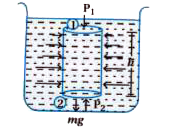Discuss the variation of pressure with depth or pressure produced due to fluid depth h and density of fluid ρ.Solution in Gujrati
Suppose a fluid of density ρ is in a static equilibrium in a container as shown in figure.

Consider a cylindrical element of fluid having area of base A and height h.
The pressure at points 1 and 2 are P1andP2 respectively.
The force acting on liquid column is as below :
(1) The forces on point −1F1=P1A (downward)
(2) The force on point −2F2=P2A (upward)
(3) Weight of fluid column W=mgW=Ahρg (downward)
Fluid column is in equilibrium hence downward forces = upward forces
F1+W=F2
∴F2−F1=W
∴P2A−P1A=Ahρg....(1)
∴P2−P1=hρg
∴P2=P1+hρg ...(2)
Equation (1) shows that pressure difference depends on the vertical distance (h) between the points (1and 2),mass density of the fluid (ρ) and acceleration due to gravity (g) but it does not depends on the area of cross section.
If the effect of gravitation is neglected
P2−P1=hρg=0
∴P2=P1
It indicates that if the effect of gravitation is neglected , the pressure at every point in fluid is same.
Let there be point 1 on the surface of container. The pressure on the surface is atmospheric pressure Pa.P1=PaandP2=P∴P−Pa=hρgorP=Pa+hρg ... (3)
P is called absolute pressure.
Equation (3) shows that the pressure P at depth below the surface of liquid open to the atmosphere is greater than atomspheric pressure by an amount hρg.
The excess of pressure , P−Pa, at depth h is called a gauge pressure at that point.
Topper's Solved these Questions
- BOOK - KUMAR PRAKASHANCHAPTER - MECHANICAL PROPERTIES OF FLUIDS EXERCISE - SECTION-A Try Yourself (VSQs)132videos
MECHANICAL PROPERTIES OF FLUIDS
- BOOK - KUMAR PRAKASHANCHAPTER - MECHANICAL PROPERTIES OF FLUIDS EXERCISE - SECTION - B Numericals29videos
MECHANICAL PROPERTIES OF FLUIDS
- BOOK - KUMAR PRAKASHANCHAPTER - MACHANICAL PROPERTIES OF SOLIDS EXERCISE - QUESTION PAPER11videos
MACHANICAL PROPERTIES OF SOLIDS
- BOOK - KUMAR PRAKASHANCHAPTER - MOTION IN A STRAIGHT LINE EXERCISE - QUESTION PAPER11videos
MOTION IN A STRAIGHT LINE
Similar Questions
What is fluid ?
01:34View SolutionA 14.5 kg mass, fastened to the end of a steel wire of unstretched 1.0 m, is whirled in a vertical circle with an angular velocity of 2 rev/s at the bottom of the circle. The cross- sectional area of the wire is 0.065 cm2. Calculate the elongation of the wire when the mass is at the lowest point of its path.
01:39View SolutionWhat is called brittle material ?
02:19View SolutionDefine frame of reference and give its types.
01:16View SolutionAssertion: At depth h below the water surface pressure is p . Then at depth 2h pressure will be 2p . (Ignore density variation). Reason: With depth pressure increases linearly.
02:55View SolutionThe pressure at depth h below the surface of a liquid of density ρ open to the atmosphere is
03:31View SolutionCalculate the pressure ant different levels of depth in fluids.
03:21View Solutionमुक्त पृष्ठ से गहराई h पर द्रव के दाब का व्यंजक लिखिए |
04:49View Solutionसिद्ध कीजिए कि किसी द्रव से भरे हुए बर्तन में गहराई पर द्रव का दाब hdg होता है, जहाँ द्रव का घनत्व d तथा g गुरुत्वीय त्वरण है |
01:58View Solutionखुले वातावरण में ρ घनत्व के एक द्रव के तल से h गहराई नीचे लगने वाला दाब।
01:42View Solutionগভীরতা বাড়লে তরলের চাপ –
02:45View Solution" " Article I h density at depth rho The fluid is behind the vertical section of the dam, the transverse length of which lambda And the area is A. Pressure on the vertical section
04:56View Solutionवायुमण्डल में खुले घनत्व ρ के किसी द्रव की सतह से नीचे गहराई h पर दाब क्या होगा?
01:00:58View SolutionAssertion: At depth h below the water surface pressure is p . Then at depth 2h pressure will be 2p . (Ignore density variation). Reason: With depth pressure increases linearly.
01:32View Solutionद्रवों के दाब का गहराई के साथ संबंध दर्शाने के लिए एक प्रयोग का वर्णन करें।
01:46View Solution

